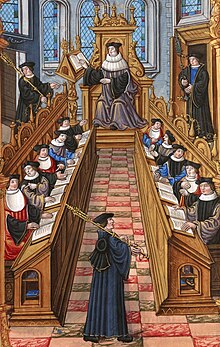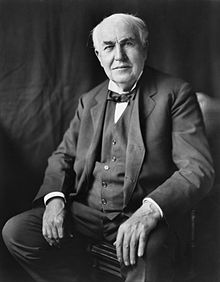The History of Science Portal
The history of science covers the development of science from ancient times to the present. It encompasses all three major branches of science: natural, social, and formal. Protoscience, early sciences, and natural philosophies such as alchemy and astrology during the Bronze Age, Iron Age, classical antiquity, and the Middle Ages declined during the early modern period after the establishment of formal disciplines of science in the Age of Enlightenment.
Science's earliest roots can be traced to Ancient Egypt and Mesopotamia around 3000 to 1200 BCE. These civilizations' contributions to mathematics, astronomy, and medicine influenced later Greek natural philosophy of classical antiquity, wherein formal attempts were made to provide explanations of events in the physical world based on natural causes. After the fall of the Western Roman Empire, knowledge of Greek conceptions of the world deteriorated in Latin-speaking Western Europe during the early centuries (400 to 1000 CE) of the Middle Ages, but continued to thrive in the Greek-speaking Byzantine Empire. Aided by translations of Greek texts, the Hellenistic worldview was preserved and absorbed into the Arabic-speaking Muslim world during the Islamic Golden Age. The recovery and assimilation of Greek works and Islamic inquiries into Western Europe from the 10th to 13th century revived the learning of natural philosophy in the West. Traditions of early science were also developed in ancient India and separately in ancient China, the Chinese model having influenced Vietnam, Korea and Japan before Western exploration. Among the Pre-Columbian peoples of Mesoamerica, the Zapotec civilization established their first known traditions of astronomy and mathematics for producing calendars, followed by other civilizations such as the Maya.
Natural philosophy was transformed during the Scientific Revolution in 16th- to 17th-century Europe, as new ideas and discoveries departed from previous Greek conceptions and traditions. The New Science that emerged was more mechanistic in its worldview, more integrated with mathematics, and more reliable and open as its knowledge was based on a newly defined scientific method. More "revolutions" in subsequent centuries soon followed. The chemical revolution of the 18th century, for instance, introduced new quantitative methods and measurements for chemistry. In the 19th century, new perspectives regarding the conservation of energy, age of Earth, and evolution came into focus. And in the 20th century, new discoveries in genetics and physics laid the foundations for new sub disciplines such as molecular biology and particle physics. Moreover, industrial and military concerns as well as the increasing complexity of new research endeavors ushered in the era of "big science," particularly after World War II. (Full article...)
Selected article -

The Condemnations at the medieval University of Paris were enacted to restrict certain teachings as being heretical. These included a number of medieval theological teachings, but most importantly the physical treatises of Aristotle. The investigations of these teachings were conducted by the Bishops of Paris. The Condemnations of 1277 are traditionally linked to an investigation requested by Pope John XXI, although whether he actually supported drawing up a list of condemnations is unclear.
Approximately sixteen lists of censured theses were issued by the University of Paris during the 13th and 14th centuries. Most of these lists of propositions were put together into systematic collections of prohibited articles. Of these, the Condemnations of 1277 are considered particularly important by those historians who consider that they encouraged scholars to question the tenets of Aristotelian science. From this perspective, some historians maintain that the condemnations had positive effects on the development of science, perhaps even representing the beginnings of modern science. (Full article...)Selected image

Science, and particularly geometry and astronomy, was linked directly to the divine for most medieval scholars. The compass in this 13th century manuscript is a symbol of God's act of creation. God has created the universe after geometric and harmonic principles; to seek these principles was therefore to seek and worship God.
Did you know
...that Einstein's famous letter to FDR about the possibility of an atomic bomb was actually written by Leó Szilárd?
...that geology was transformed in the latter part of the 20th century after widespread acceptance of plate tectonics?
...that the idea of biological evolution dates to the ancient world?
Selected Biography -
Thomas Alva Edison (February 11, 1847 – October 18, 1931) was an American inventor and businessman. He developed many devices in fields such as electric power generation, mass communication, sound recording, and motion pictures. These inventions, which include the phonograph, the motion picture camera, and early versions of the electric light bulb, have had a widespread impact on the modern industrialized world. He was one of the first inventors to apply the principles of organized science and teamwork to the process of invention, working with many researchers and employees. He established the first industrial research laboratory.
Edison was raised in the American Midwest. Early in his career he worked as a telegraph operator, which inspired some of his earliest inventions. In 1876, he established his first laboratory facility in Menlo Park, New Jersey, where many of his early inventions were developed. He later established a botanical laboratory in Fort Myers, Florida, in collaboration with businessmen Henry Ford and Harvey S. Firestone, and a laboratory in West Orange, New Jersey, that featured the world's first film studio, the Black Maria. With 1,093 US patents in his name, as well as patents in other countries, Edison is regarded as the most prolific inventor in American history. Edison married twice and fathered six children. He died in 1931 due to complications from diabetes. (Full article...)Selected anniversaries
- 1570 - Cartographer Abraham Ortelius issues the first modern atlas.
- 1722 - Death of Sébastien Vaillant, French botanist (b. 1669)
- 1755 - Death of Johann Georg Gmelin, German naturalist and geographer (b. 1709)
- 1782 - Death of William Emerson, English mathematician (b. 1701)
- 1793 - Death of Charles Bonnet, Swiss naturalist (b. 1720)
- 1851 - Birth of Emile Berliner, German-born telephone and recording pioneer (d. 1929)
- 1860 - Birth of Eduard Buchner, German chemist, Nobel Prize laureate (d. 1917)
- 1891 - Thomas Alva Edison displays the first prototype kinetoscope.
- 1918 - Birth of Edward B. Lewis, American geneticist and Nobel Prize laureate (d. 2004)
- 1947 - Death of Philipp Lenard, Austrian physicist and Nobel Prize laureate (b. 1862)
- 1983 - First publications of the discovery of the virus that causes AIDS in the journal Science by Luc Montagnier
- 1996 - First naked eye observation of Comet Hale–Bopp
- 2002 - Death of Stephen Jay Gould, American paleontologist (b. 1941)
Related portals
Topics
General images
Subcategories
Things you can do
Help out by participating in the History of Science Wikiproject (which also coordinates the histories of medicine, technology and philosophy of science) or join the discussion.
Associated Wikimedia
The following Wikimedia Foundation sister projects provide more on this subject:
-
Commons
Free media repository -
Wikibooks
Free textbooks and manuals -
Wikidata
Free knowledge base -
Wikinews
Free-content news -
Wikiquote
Collection of quotations -
Wikisource
Free-content library -
Wikiversity
Free learning tools -
Wiktionary
Dictionary and thesaurus








































































